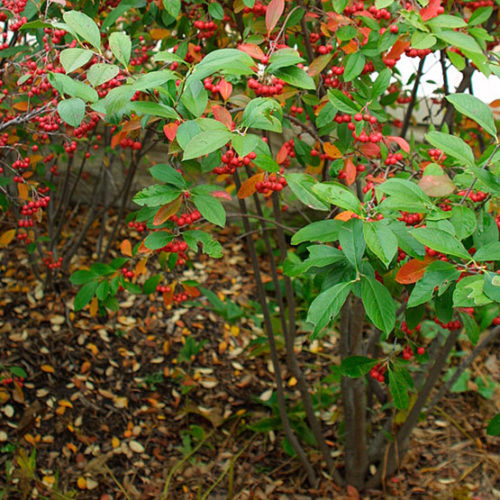Red Chokeberry A Legacy in Nature
Throughout history, the Red Chokeberry or Aronia arbutifolia has become an integral component of natural environments and human customs. Before European settlers reached North America Indigenous peoples valued this plant because they used it as both food and medicine. The roots of this species extend to eastern North America where it flourished in natural habitats including wetlands and forest margins that possess wet soils. European explorers quickly integrated the plant into their daily uses by creating preserves from its berries and preparing medicinal remedies from its leaves and bark. The plant's ability to endure various conditions and adapt to different environments made it an essential component of ecosystems for several centuries.
Red Chokeberry Traditional and Modern Medicinal Uses
The medicinal properties of Red Chokeberry have earned it respect for centuries. Native tribes preserved berries through drying methods and incorporated them into teas and poultices to treat everyday medical conditions. The small fruits contain antioxidants which were believed to help maintain immune function while also promoting digestive health. Historic herbal practitioners valued this plant for its anti-inflammatory properties and some incorporated it into treatments for colds and fevers.
Scientific research today supports traditional applications by revealing the berry's significant flavonoid and polyphenol content. Herbal practitioners continue to use this plant in health programs because it helps support cardiovascular function and reduces oxidative stress. The wellness industry regularly features nutritional supplements and extracts from this plant with claims of immune system enhancement and overall vitality support. Current research on its health advantages keeps the plant valuable for both medical properties and its ornamental and ecological uses.
Discovery and Botanical Classification
European botanists formally documented Aronia arbutifolia in the 18th century during their study of North America’s diverse plant life. Within the Rosaceae botanical family, it belongs to Aronia arbutifolia and shares close relationships with other fruit-bearing species. Indigenous groups have known and used this plant for many generations, but its formal inclusion in botanical literature has established its role in both horticulture and ecological studies.
The plant gained widespread cultivation and recognition for its ability to thrive in difficult soil environments over time. European horticulturists embraced its cultivation and the species became widespread throughout botanical gardens and naturalized areas. Scientists continue to investigate this well-documented species because of its environmental benefits and practical uses.

Red Chokeberry A Stunning Addition to Landscapes
Aronia arbutifolia has gained popularity for decorative use in gardens and landscapes beyond its historical and medicinal importance. During springtime the plant displays its beauty through clusters of snowy to pale pink blooms that draw pollinators. The initial flowers transform into vivid clusters of berries which mature from green to deep crimson hues contrasting with the shiny green leaves.
The most breathtaking feature of this plant lies in its dramatic fall transformation. The plant's foliage bursts into vibrant reds, oranges and burgundies when temperatures fall and creates a stunning visual focal point in any landscape setting. This plant is commonly selected for urban and rural landscapes because it grows well in diverse settings such as rain gardens and naturalized areas. Because it handles wet soils well, this plant has become a preferred option for erosion management since it helps maintain the integrity of banks and slopes and brings seasonal charm.
A Distinct Appearance with Seasonal Appeal
Red Chokeberry stands out among landscape plants because of its visual allure throughout multiple seasons. It develops in a multi-stemmed upright form which reaches heights between six to ten feet. The graceful arching of its slender branches creates a beautiful silhouette that maintains its elegance throughout winter after the leaves drop. During winter months the rounded berry clusters stay intact on plants which provide colorful accents to bare winter scenes.
This plant remains an outstanding choice for gardeners because its glossy dark green foliage creates a lush background throughout the entire year and is suitable for both formal and natural landscapes. When grown individually or within a mixed hedge, this plant maintains year-round visual interest through its spring flowers and striking fall foliage display.
Rare Wildlife Visitors and Ecological Benefits
Aronia arbutifolia serves as an essential food source for wildlife by attracting multiple species that depend on its flowers, leaves, and fruit. Pollinators like bees and butterflies find essential early-season nourishment from this plant's nectar-rich flowers. The berries have a tart flavor that humans find unappealing but provide essential nourishment for birds when other fruits dwindle in the late fall and winter months.
Small mammals frequently feed on its berries while its thick growth provides shelter and nesting areas. This species enhances biodiversity by providing habitat for various insects as well as specialist pollinators which help sustain local ecosystem health. This species stands out from many cultivated shrubs because it provides essential resources for native wildlife populations.
Red Chokeberry A Timeless Botanical Treasure
Because of the red chokeberry's long-standing historical significance combined with powerful medicinal qualities and remarkable visual beauty, Aronia arbutifolia remains an esteemed plant in both landscaping and natural settings. The species stands out for its resilience alongside its aesthetic appeal and ecological importance which has earned it admiration from past generations and future ones alike. This plant stands out in any environment because of its seasonal beauty and health advantages along with the wildlife support it offers.